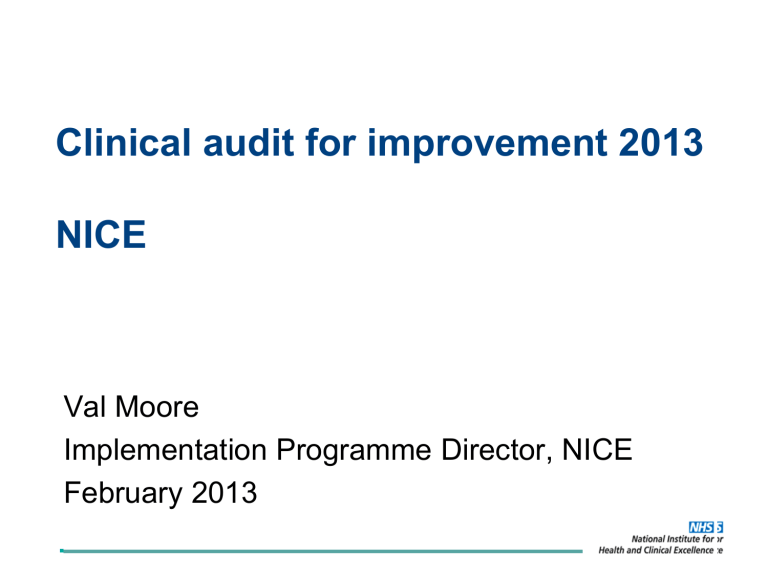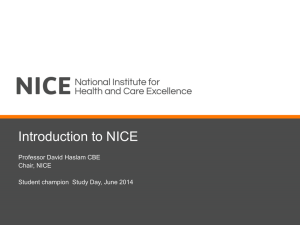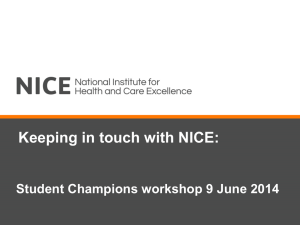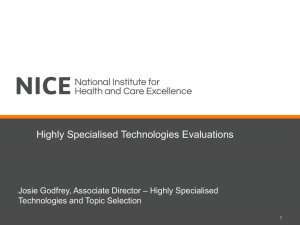see Powerpoint presentation

Clinical audit for improvement 2013
NICE
Val Moore
Implementation Programme Director, NICE
February 2013
To cover
• An update from NICE
• NICE Quality Standards, feedback from the field and support for service improvement and measurement
• The role of clinical audit in monitoring adherence to standards?
The beginning
• NICE was launched in 1999 as the
National Institute for Clinical
Excellence to drive the uptake of new technologies across the NHS and standardise care.
• Initial work programme was the development of recommendations on new technologies, based on an assessment of clinical and cost effectiveness.
Guidance NHS & patients
Followed by…. significant growth
250
200
150
100
More guidance for the NHS: clinical guidelines, interventional procedures, medical technologies
Public health guidance
Implementation programme
NHS Evidence and the National Electronic Library for
Medicines – and accreditation
The British National Formulary transfer
National Prescribing Centre
Quality standards
50
0
2000/1 2001/2 2002/3 2003/4 2004/5 2005/6 2006/7 2007/8 2008/9 2009/10 2010/11
Current NICE functions
Evidence-based products:
Guidance
Quality standards
Evidence summaries
Evidence alerts
Accredited evidence
Prescribing advice
Dissemination and adoption support:
NHS Evidence
NICE website
Pathways
Apps
E-alerts
Implementation tools
Audiences:
NHS
Patients and the public
Public health
Local government
The future – what’s on the horizon
• Social care:
– Guidance
– Quality standards
– Support for uptake
• Health
– Standards & indicators
• Technology assessment
– Value-based pricing
– Highly specialised technologies (HST)
• Adoption of new technologies
– Transfer of the NHS Technology Adoption Centre
– Innovation Health and Wealth
• New relationships – and a new status
Guidance and quality standards
A comprehensive set of recommendations for a particular condition or service area
Evidence Guidance
Quality
Standards
‘Sentinel markers’
A prioritised set of concise, measureable statements designed to drive quality improvements across a pathway of care.
Annual NICE field team visits to over
500 top teams or key opinion formers and 100 meetings and events
And exceeds 80% coverage of NHS organisations
And 80% of upper tier local authorities
Provider perspectives
“I wasn’t aware of quality standards until you explained what they are. I can see how they can help drive improvements in patient outcomes. They are obviously very significant and we should be using them....but how?”
Mental Health Medical Director
Provider perspectives....positives
• Extremely useful tool to improve quality and challenge assumptions that good quality care is already delivered
• Supportive of the aims of quality standards
• Easy to read and practical
• We are using them!
Provider perspectives....positives
• Extremely useful tool to improve quality and challenge assumptions that good quality care is already delivered
• Supportive of the aims of quality standards
• Easy to read and practical
• Examples:
• Stroke QS helped Camden Provider Services improve access to physiotherapy - now offered to 90% of appropriate patients
• Taunton & Somerset NHS FT used specialist neonatal care QS as a quality improvement lever - parents involvement within 24 hrs of admission
Provider perspectives......negatives
• Unaware, or aware of QS but not sure how to use them/significance
• Think commissioners will use them to withhold payment
• Difficult to measure as they cut across organisational boundaries - worry over the potential number of measurable indicators
• Not mandatory therefore not a priority
• Perceived to be overly complex
• The suggested measures and definitions do not always read across to measures routinely collected as part of national data sets or national audits
Commissioner perspectives....positives
• ‘QS are excellent’ - mainly positive feedback about their potential value for commissioners and service providers
• Aware of QS and beginning to incorporate them into contracts and service specifications
• A “springboard” for service redesign and quality improvement (example Oxfordshire/ Bucks CCG)
• Can be used to commission evidenced-based best practice services
• Can drive improvements in quality through links to reimbursements
• Used by Trusts for contracting/procurement
Commissioner perspectives....negatives
• Growing awareness but not complete
• Not sure how to use them
• Not effective to use quality standards as a CQUIN
• Comments on alignment to the provisional CCG
Commissioning Indicators set
• The volume of quality standards may overwhelm the capacity of the health and social care system to respond
• Perceived “burden” of data collection especially for providers
• Need to know that a dialogue is in place with CQC,
OFSTED and NHSLA
Quality measures and indicators for
NICE quality standards
Quality Measures Formal Indicators
• Broad definitions
• Additional definitions may be needed and can be adapted for local use
• Not formally tested
• Use - Provide a focus for quality improvement activity
• Highly defined and reproducible
• Cannot be adapted and definitions should be followed
• Tested as part of development process
• UseProvide a focus for quality improvement activity
• Provide a mechanism for comparison
Measurement support products at launch of the quality standard
• Commissioning and benchmarking ( and budgeting) tools
• Action planning
• Data collection tools
• The H&SC Information Centre continues to produce quality assured indicators derived from quality standards - approved by independent committee for the menu on the NICE website
Support for commissioners using the quality standard
Support to consider the cost of implementing the changes required to achieve the quality standard at a local level
Identifies potential savings
Highlights areas of care with potential implications for commissioners
Signposts commissioners and service providers to a package of support tools to assist implementation of NICE guidance and service redesign
40 published
Guides for commissioners
Support resource for every QS
Quality standards
Action planning tool for use by commissioners or providers
Data collection tool
Data collection tool for all suitable process measures involving patient/ service user records
Back to the future of NICE…social care pilots
• Combined dementia (interventions and care) quality standard to be published in April
• Care audit pilot on dementia care in residential homes planned for 2014 – HQIP and SCIE leading this
• Care of looked after children quality standard to be published in April
• National Collaborating Centre appointed to develop guidance from April 2103 (SCIE and partners)
Referred social care topics and timelines
Topic Guidance
Mental wellbeing in older people
Already available
Autism in adults and children Already available
Medicines management in care homes
2014
Transition between health and social care
2015
2015 Older people with multiple comorbidities
Domiciliary care 2015
Child maltreatment
Transition between child adult services
2015
2015
Quality Standard
Late 2013
Late 2013
2015
2016
2016
2016
2016
2016
Highly specialised technology assessment (HST)
• Ministerial request to assess very high cost, low volume drugs (and potentially other technologies) for people with rare or very rare conditions from April 2013.
• A role currently provided by Advisory Group for National
Specialised Services - AGNSS
• Interim process likely to include:
– Current NICE appraisal topic selection process
– Company submission plus academic review
– New Advisory Committee for HST
– Adaptation of AGNSS decision making framework
– Public consultation and appeal
– Formal link to nationally commissioned specialised services
– Guidance to the NHS and funding direction
Value-based pricing – how it might work
• Only new medicines launched after January 2014
• Higher price thresholds for medicines that:
– Tackle disease of high unmet need or severity
– Demonstrate greater therapeutic improvements and innovation
– Demonstrate wider societal benefits
• Categories and weights determined by the Secretary of
State for Health:
– On the basis of empirical research
– Within a framework determined in advance
NHS Technology Adoption Centre
• NTAC established at the end of 2007 to provide a more systematic approach to adoption of new technologies.
• Aims to enable organisations to better understand and overcome their adoption barriers.
Their mission is: “To work directly with industry and the NHS at a clinical, managerial and procurement level to identify and overcome the hurdles to adoption for innovative technologies which have already demonstrated clear benefits to patients and will improve system efficiency.”
Transfer of NTAC to NICE
• The proposal in the Sunset
Review is to transfer NTAC to
NICE
• Alongside other NICE implementation functions, this provides a focus on supporting uptake of new technologies
• It will add capacity to work with the Innovation Health and
Wealth agenda.
Innovation health and wealth
Key areas relevant to NICE:
– A NICE Implementation
Collaborative to support the implementation of NICE guidance
– A ‘ NICE compliance regimen ’ for the funding direction attached to
NICE TAs, to ensure rapid and consistent implementation – innovation scorecard and work on local formularies
– Working with Academic Health
Science Networks
Climate conducive to promoting uptake
Future NICE functions
Evidence-based products:
Guidance
Quality standards
Evidence summaries
Evidence alerts
Accredited evidence
Prescribing advice
Value-based pricing assessment
Indicator sets
Dissemination and adoption support:
NHS Evidence
NICE website
Pathways
Apps
E-alerts
Implementation tools
Focussed support
Audiences:
NHS
Patients and the public
Public health
Local government
Social care
Commissioners








